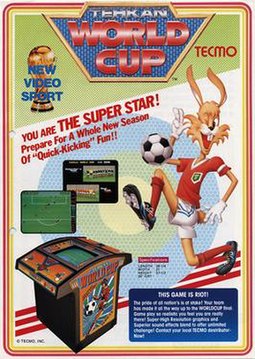Tehkan World Cup
| Tehkan World Cup | |
|---|---|
 North American arcade flyer | |
| Developer(s) | Tehkan |
| Publisher(s) | Tecmo |
| Composer(s) | Tsukasa Masuko |
| Platform(s) | Arcade |
| Release | |
| Genre(s) | Sports game (soccer) |
| Mode(s) | Single-player Multiplayer |
Tehkan World Cup is a multi-player soccer game featuring a trackball controller. Programmed by Michishito Ishizuka it was released to arcades in 1985 by Tehkan, Ltd., the former name of Tecmo, Inc. Its arrival coincided with the buildup to the 1986 FIFA World Cup. It featured the then colors of several of the world's top teams such as West Germany, Argentina and Brazil, although it did not mention any team by name. It was most commonly released in a cocktail cabinet form factor, while graphically it offered a two-dimensional birds-eye view of the field that was unique for its time. Its trackball control system contributed significantly to its gameplay which was relatively speedy and exhibited a fluidity something akin to ice hockey, with as little as 3 seconds required to score from kick-off. Two-player action could be highly competitive, with players facing each other across the game space while using sweeping arm movements reminiscent of table tennis.
Tehkan World Cup was released in 2004 for the PlayStation 2 and in 2005 for the Xbox, in both cases under the name Tecmo Cup.
Reception
In Japan, Game Machine listed Tehkan World Cup on their February 15, 1986 issue as being the third most-successful table arcade unit of the year.[3]
References
- ^ "Tehkan World Cup - Videogame by Tehkan".
- ^ "The Arcade Flyer Archive".
- ^ "Game Machine's Best Hit Games 25 - テーブル型TVゲーム機 (Table Videos)". Game Machine (in Japanese). No. 278. Amusement Press, Inc. 15 February 1986. p. 21.
